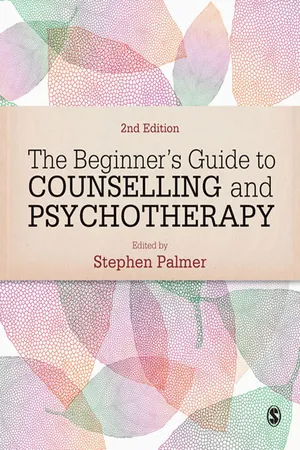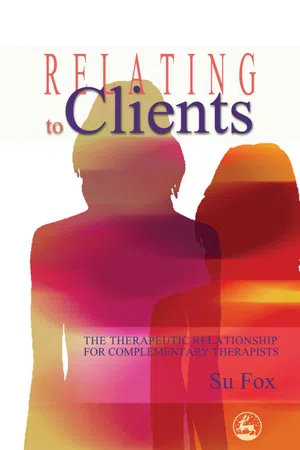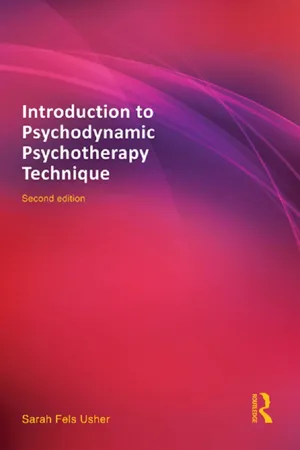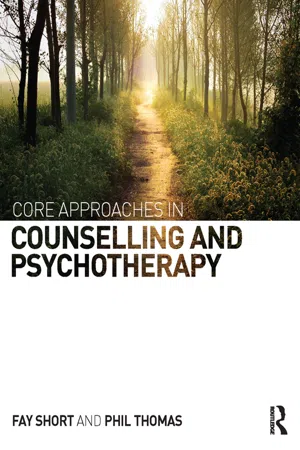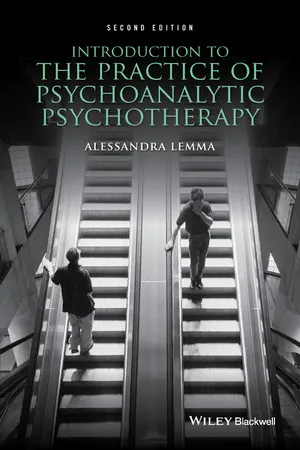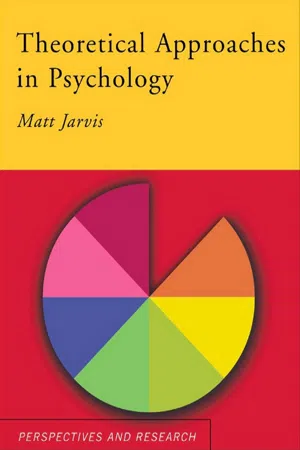Psychology
Psychoanalytic Therapy
Psychoanalytic therapy is a form of psychological treatment based on Sigmund Freud's psychoanalytic theory. It aims to explore unconscious conflicts and unresolved issues that may be causing emotional distress or behavioral problems. Through techniques such as free association and dream analysis, this therapy seeks to bring repressed thoughts and feelings to the conscious mind, leading to insight and healing.
Written by Perlego with AI-assistance
Related key terms
9 Key excerpts on "Psychoanalytic Therapy"
- Stephen Palmer(Author)
- 2015(Publication Date)
- SAGE Publications Ltd(Publisher)
4 Psychodynamic (Freudian) Counselling and PsychotherapyLesley MurdinIntroduction
Freudian psychodynamic therapy is the practice of coming to understand what goes on in your mind beyond the edge of your consciousness. Sometimes you think or say something and wonder ‘what came over me?’ What came over you was an unconscious wish that bore little or no relation to what you consciously want to do. Unconscious wishes become understandable in relation to two key themes. The infant has desires that can be described as sexual and they coalesce in the Oedipus complex, which describes through the myth the child’s emotional connections, anxieties and desires with each of the parents or significant others.A psychodynamic therapist seeks to understand the effect of these early relations on the adult in the present and therefore for the future.This does not mean that the present or the conscious intention is ignored. This therapy is mainly concerned with the present and seeks to find ways of making the past a help not a hindrance. The name implies the dynamic nature of the psyche in which conflict between wishes and demands causes suffering. Conflicts are brought into the open because they are repeated and repetitions are emphasised in a paradoxical process of leaving the past behind.Development of the Therapy
Psychodynamic therapy was given a coherent body of theory by Sigmund Freud (1856–1939). Freud was trained as a doctor and his theory takes account of the needs and demands of the body although he developed a ‘talking therapy’. Freud saw himself as a scientist and his ideas were derived from observation. He was ready to change his view if observation led to a different conclusion. The value of talking emerged with Josef Breuer, whose patient lost her symptoms by remembering difficulties with her father. Freud and Breuer published an account of her therapy1 and so founded the modern discipline.- eBook - ePub
- Allan Tasman, Jerald Kay, Jeffrey A. Lieberman, Michael B. First, Mario Maj(Authors)
- 2011(Publication Date)
- Wiley(Publisher)
CHAPTER 87 Individual Psychoanalytic Psychotherapy Jerald Kay Rena L. Kay Department of Psychiatry, Wright State University Boonshoft School of Medicine, Dayton, OH, USAPsychoanalytic theory provides the modern clinician with a comprehensive system for the understanding of personality development, the meaningfulness of human conflict and emotional pain, and the mutative factors within the doctor–patient relationship. Psychoanalysis is a general psychology, a developmental theory, and a specific treatment. Since its inception, psychoanalytic theory has undergone numerous and substantial revisions. Its history and the movements that contributed to its evolution are described in Chapter 28. With respect to psychoanalysis as a treatment approach, its history has been punctuated by persistent attempts both to simplify the psychoanalytic technique and to shorten its duration of treatment. The synonymous terms psychoanalytic psychotherapy, psychoanalytically oriented psychotherapy, psychodynamic psychotherapy, and expressive psychotherapy have come to represent the most coherent of these attempts.For many years after World War II, there was an intense controversy among psychoanalysts about the merit of psychoanalytic psychotherapy because it was considered to be a diluted form of psychoanalysis with poorly defined techniques and goals. Today, for a number of reasons, this issue seems to be less important. First, and most recently, managed care, with its emphasis on cost containment and fiscal accountability, has attributed greater importance to episodic care through briefer psychotherapeutic interventions. Second, compared with 20 years ago, psychoanalysis as a treatment option is no longer equitably reimbursed by third-party payers. As a result, many analysts devote more of their professional time to psychoanalytic psychotherapy than psychoanalysis. Third, with only a few notable exceptions, psychoanalysis has all but moved out of psychiatry departments in academic health centers, and most residency training curricula now focus much more on the basic and practical applications of psychoanalytic theory and technique and not on more traditional psychoanalytic metapsychology. Moreover, during the last 35 years, many new, brief, psychoanalytically informed psychotherapies have been developed. These include, but are not limited to, the methods of Malan (1976), Mann (1973), Sifneos (1979), Davanloo (1978), Horowitz et al. (1984), Luborsky (1984), Milrod et al. (1997), and Strupp and Binder (1984). Manual-driven psychotherapies with demonstrated treatment efficacy, such as interpersonal psychotherapy and some forms of cognitive–behavioral psychotherapy, also incorporate many traditional psychoanalytic notions about the physician-patient relationship and the role of interpretation. Last, psychoanalytic theory has remained relatively dynamic and has integrated and consolidated the advances from object relations theory, self psychology, interpersonal theory, and the renewed interest in the study of psychic trauma. This has permitted, in the case of severe personality disorders and serious developmental trauma, the psychodynamic treatment of a broader range of psychological problems than was previously considered possible through classical psychoanalysis. - eBook - ePub
Relating to Clients
The Therapeutic Relationship for Complementary Therapists
- Su Fox(Author)
- 2007(Publication Date)
- Jessica Kingsley Publishers(Publisher)
8 Psychotherapy and the Therapeutic RelationshipOver time, psychotherapy and, in particular, psychoanalysis, which is one branch of psychotherapy, or maybe more accurately the trunk from which all other branches grew, has developed a repertoire of concepts and ways of thinking about our inner worlds, how they might function, how our inner world is affected by events in the outer world, particularly how this affects our relationships with others. Some of the words that psychoanalysts use are now part of our everyday language. It’s hard to imagine, for example, that only 200 years ago, the idea that we had something called an unconscious didn’t exist. Possibly more has been written about Freud, and what he really meant, than about any of the great twentieth-century thinkers, and there is no doubt that his work changed our thinking.Let’s suppose you decide to go and see a psychoanalyst. He or she will use his or her understanding of psychoanalytic concepts as tools to treat your problem, in the same way that many complementary therapists use their hands as tools to treat a problem. Your analyst will also focus on the relationship between the two of you in the consulting room as a means of attending to difficulties in your inner world. This is where the term ‘the therapeutic relationship’ originated, in this form of psychotherapy that actually uses the relationship between therapist and patient as the medium in which healing occurs. All schools of psychotherapy today have either grown directly out of Freud’s legacy, or owe him some debt.This chapter will attempt to explain some psychotherapy terms as simply as possible, together with a little about the historical context in which they emerged. Remember, they are only ideas, not necessarily right or wrong, but ideas that can offer us a framework for looking at our inner worlds and the relationships we have with other people, including those we work with, just as the anatomical model of the body, homeopathic pictures, the chakra system, and the seven elements of traditional Chinese medicine (TCM) are also frameworks that explain particular phenomena. - Sarah Fels Usher(Author)
- 2013(Publication Date)
- Routledge(Publisher)
As the therapist listens, he or she begins to make connections between the patient’s current thoughts and feelings and their past experiences—sometimes very early ones. Some of these experiences have been “forgotten” or repressed, and can only be seen in their current—often disguised or distorted— manifestations, for example, a phobia, or an unusual mannerism, or indeed, the patient’s transference reactions, to be discussed later. It is from these thoughts and feelings that we infer the underlying inner psychological processes.In both the psychoanalytic and the psychodynamic approaches, the meaning of the patient’s symptomatology (e.g., anxiety) is thought about in the context of an overall picture of the person as a dynamic, growing, feeling human being, with conflicts, fears, anxieties, and psychological defences. The patient’s ability to form close relationships—both within the family and outside it— his or her character/ego strengths and weaknesses, preference for certain styles of coping, and how these factors shape character, are all part of, and useful in, a psychodynamic approach.Psychologists who administer and interpret projective tests (e.g., the Rorschach) are accustomed to the detective work of discovering what makes a person tick. It may be helpful for therapists to read psychological reports that focus on unconscious dynamics, and then to watch for them in the therapy situation. Psychodynamic treatment is always informed by an understanding of the relationship the patient develops with the therapist (see the sections on Transference and Working Alliance). To greater or lesser degrees, this relationship becomes the fulcrum for the treatment; in this type of therapy, it should never be ignored.History
The psychodynamic approach is essentially an historical approach to treatment, meaning that the therapist’s comments—observations and interpretations— which help the patient understand their behaviour will, at least in part, be based on the therapist’s knowledge of the patient’s history (i.e., their early upbringing and family life). As Basch (1980) puts it:- eBook - ePub
- Fay Short, Phil Thomas(Authors)
- 2014(Publication Date)
- Routledge(Publisher)
This chapter aims to introduce the reader to the psychodynamic approach to counselling and psychotherapy. Psychoanalytic Therapy will be explored as one example of a therapeutic method under the psychodynamic approach.LEARNING OUTCOMES By the end of this chapter, you will be able to:• describe the development of the second force in psychology: the psychodynamic approach• acknowledge the relative impacts of Sigmund Freud and Melanie Klein on the development of the psychodynamic approach• discuss the core theories of human nature and personality from the psychodynamic perspective• discuss the nature of the therapeutic relationship between therapist and client in Psychoanalytic Therapy• outline the main therapeutic techniques utilised in Psychoanalytic Therapy• appreciate the application of Psychoanalytic Therapy in a real-world settingDEVELOPMENT OF THE PSYCHODYNAMIC APPROACH
LEARNING OUTCOMES After reading this section, you will be able to:• list the three main forces in psychology• discuss the development of the psychodynamic approach in a historical context• acknowledge the main contributors to the development of the psychodynamic approachSecond force in psychology
Three forces in psychology Behavioural theory Psychodynamic theory Humanistic theory Psychodynamic psychology is the ‘second force’ Developed alongside the behavioural approach as the two reacted against one another - eBook - ePub
Time-limited Psychodynamic Psychotherapy with Children and Adolescents
An interactive approach
- Ruth Schmidt Neven(Author)
- 2016(Publication Date)
- Routledge(Publisher)
As practitioners we are aware of the urgent mental health needs of many of the children and young people who come to our attention. This means that we must assert the primacy of the needs of the child and young person and act as their advocates. This urgency requires first and foremost a more open and critical dialogue about how our psychotherapeutic practice can address these urgent needs. It follows that the development of new theory must emerge directly from clinical practice, experience and observation, rather than from imposing theory that adheres primarily to established orthodoxies. In this book an attempt is made to provide a fresh perspective of the rich field of psychodynamic understanding and how it can be applied to time-limited psychotherapy, not only with children and young people, but also with their parents and caregivers.The new century has inevitably prompted a reassessment and re-evaluation of many of the accepted and traditional frameworks with respect to our understanding of the social, health, economic, political and environmental issues with which we are concerned. Psychoanalysis has not escaped this scrutiny. On the one hand, we may contend that the death of psychoanalysis is greatly exaggerated since so many psychoanalytic concepts are now integral to the web and waft of daily life as to be almost imperceptible as to their origins. On the other hand, psychoanalysis and its offshoot psychotherapy as a treatment mode have not fared so well, although the theoretical study of psychoanalysis continues to evoke interest within the academic realm. The fact that psychoanalytic or psychodynamic treatments are not generally in current favour is due at least in part to a cost-cutting economic climate. This has tended to elevate cognitive behavioural therapies as the apparently only evidenced-based cure-all, particularly as it has the advantage of being time-limited. However, there are a number of other reasons for the apparent marginalising of psychodynamic psychotherapy; the most predominant of which is the reluctance of its practitioners to fully engage with the changing social and emotional landscape in which they practise. This is a particularly critical factor for those psychotherapists who work with children, parents and families, where the issues of social change are at the tipping point, since it is within the family context and the rearing of the next generation that the demands and challenges for change are largely generated. - Alessandra Lemma(Author)
- 2015(Publication Date)
- Wiley-Blackwell(Publisher)
While recognising that psychoanalysis is not a universal treatment for all types of psychopathology, and recognising that certain severe psychopathologies require psychoanalytic psychotherapy rather than psychoanalysis proper … a prevalent attitude has been not to investigate these fields within the realm of psychoanalytic institutes and societies. The fear has been that focused attention on such related and derivative fields might dilute the nature of psychoanalytic practice, threaten the identity of the psychoanalytic practitioner and tend to confuse the work of psychoanalysts with that of less well, or idiosyncratically, trained practitioners in the sociocultural environment (Kernberg, 2002: 328).Conventionally, the difference between psychoanalysis proper and Psychoanalytic Therapy is conceptualised, partly pragmatically, in terms of the frequency of sessions where psychoanalysis refers to at least four to five weekly sessions, whereas Psychoanalytic Therapy refers to anything up to three weekly sessions. Psychoanalysis is often also characterised by an absence of specific goals (i.e. it is open-ended) with the aim of significant character change, whereas Psychoanalytic Therapy is described as focusing on more circumscribed goals and aiming only for modifications of behaviour and character structure. However, these distinctions do not hold up to close scrutiny: even Psychoanalytic Therapy can stretch in an open-ended manner over many years and its goals can be as ambitious and far reaching as those of a full analysis. Of course, the more frequently the patient attends sessions, the less skewed the therapy becomes towards an exploration of the week's events, so that more time can be devoted to exploring the unconscious and a more intense transference relationship often develops.Looked at dispassionately, the aims of the two approaches are not significantly different; nor are there differences in the techniques used or in the theories that purport to support them. Both approaches focus on the interpretation of transference, though in briefer and less intensive psychoanalytic therapies only partial aspects of the transference are interpreted, consistent with the particular focus of the therapy and the goals of a given patient. Although some might argue that Psychoanalytic Therapy makes use of a broader range of interventions than psychoanalysis proper, for example, supportive interventions or clarifications, this is unlikely to be supported by evidence because no analytic treatment relies exclusively on interpretation alone.- eBook - ePub
- Matt Jarvis(Author)
- 2005(Publication Date)
- Routledge(Publisher)
events to the unconscious mind, and by unconscious motives. Although consciously, Alex thought she was taking her sister to sea for a birthday treat, the event seems to have quite a different meaning to her unconscious mind. We might even wonder whether Alex was motivated on an unconscious level to take her sister to sea again in order to kill her.- In contrast to other branches of psychology which place a strong emphasis on systematic, scientific research,
psychodynamic psychology looks for information in dreams, symptoms, irrational behaviour and what patients say in therapy.(Adapted from Rycroft, 1968; Tavris and Wade, 1997; Jarvis, 2000)If you know very little about psychology, and you have heard of just one psychologist, the chances are that this is Sigmund Freud, the founder of the psychodynamic approach to psychology, or psychoanalysis. If Freud (or at least Freud as he is popularly portrayed) represents your layperson’s idea of psychology then you probably have an image of a patient lying on a couch talking about their deepest and darkest secrets. In deliberate contrast to behavioural psychology, examined in Chapter 2 , psychodynamic psychology ignores the trappings of science and instead focuses on trying to get ‘inside the head’ of individuals in order to make sense of their relationships, experiences and how they see the world.In this chapter we can look at the work of Freud and that of one other influential psychoanalyst, Donald Winnicott. We can then look at how psychodynamic principles have been applied in the field of mental health, and use them to try to understand the popularity of monsters, a seemingly irrational phenomenon common throughout history and common to many cultures.Freud’s theories
Sigmund Freud (writing between the 1890s and the 1930s) developed a collection of theories which have formed the basis of the psychodynamic approach to psychology. His theories are clinically derived—i.e. based on what his patients told him during therapy. Freud theorised on a wide variety of topics and developed his ideas throughout the period of his writing. It is not possible to overview all or most of Freud’s ideas in this chapter, but we can look briefly at a few of Freud’s more important contributions. - eBook - ePub
- Sohan Modgil, Celia Modgil(Authors)
- 2012(Publication Date)
- Routledge(Publisher)
Part VII:Psychotherapy and Freudian Psychology
11. Psychotherapy and Freudian Psychology
EDWARD ERWINSTANDARD Psychoanalytic Therapy
In some of his papers Eysenck has discussed standard Psychoanalytic Therapy and ‘eclectic’ psychotherapy. In this section I will discuss only the former.Standard (or orthodox) psychoanalysis is a lengthier form of treatment than most other forms of psychotherapy, lasting two years or more on average. It involves systematic use of free association, interpretation and transference neurosis, and normally has as its goal the uncovering and resolution of the major emotional problems thought to originate in the patient's childhood (White, 1956, p. 322).In his (1952) paper Eysenck concluded, on the basis of studies by Denker (1946) and Landis (1938), that roughly two-thirds of neurotic patients recover or improve to a marked extent within about two years of the onset of their disorder, whether they are treated by psychotherapy or not. This so-called ‘spontaneous remission’ rate was then compared to the improvement rate for psychoanalytic and eclectic treatment. Because neither type of therapy showed a greater than two-thirds improvement rate, Eysenck concluded that the data failed to prove that psychotherapy, Freudian or otherwise, facilitates the recovery of neurotic patients. He also pointed out that there were problems with the data and that they did not necessarily disprove the possibility of therapeutic effectiveness. In subsequent publications, especially in Eysenck (1966), he again stressed that his conclusion was (1) that firm evidence of psychoanalytic effectiveness was lacking, and not (2) that psychoanalysis is ineffective. Despite these warnings, many critics have raised objections that are telling only if Eysenck had been trying to demonstrate thesis (2). See, for example, Smith et al.
Learn about this page
Index pages curate the most relevant extracts from our library of academic textbooks. They’ve been created using an in-house natural language model (NLM), each adding context and meaning to key research topics.
